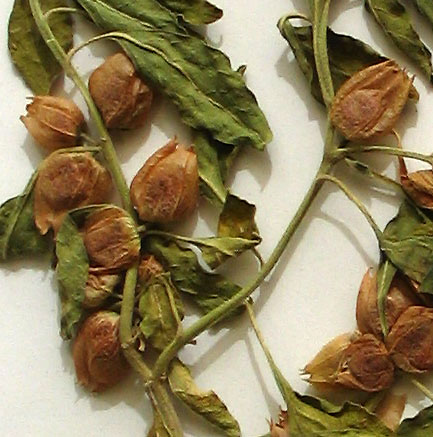
Synonymy
*Withania somnifera (L.) Dunal in DC., Prodr. 13(1): 453 (1852)
Physalis somnifera L., Sp. Pl. 1: 182 (1753).
T: "Habitat in Mexico, Creta, Hispania."; Lectotype : Herb. Linn. No. 247.1 (LINN) fide Schönbeck-Temesy in Rechinger (ed.), Fl. Iranica 100 : 27 (1972). See The Linnaean Plant Name Typification Project pages on the Natural History Museum site.
Description
Erect shrub to 1 m. All parts grey-pubescent with dendritic hairs.
Leaves ovate, the lamina up to 8 cm long, and 4.5 cm wide, usually c. 5 cm long, 3 cm wide; petiole c. 1 cm long.
Inflorescence a congested cluster of 4–6 flowers; pedicels 3–5 mm long. Calyx 4–6 mm long at time of flowering; lobes shortly triangular with linear apices, 2–3 mm long. Corolla 5–6 mm long, dull yellow-green; lobes triangular, 1.5–3 mm long, spreading. Anthers 1 mm long. Ovary obtusely conical, 1–1.5 mm long; style 3 mm long.
Berry globular, 5–10 mm diam., shining red, surrounded by urn-shaped inflated calyx, the tube 15–20 mm long. Seeds more or less disc-shaped, 1.5–2.2 mm long, light brown.
Distribution and ecology
An uncommon weed known from Eyre Peninsula in S.A. and the north coast of N.S.W. It is thought to be native to India although being found in many other countries, but this may just reflect its long term medicinal use in that country.
Grows in shallow rocky soil.
Common name
In Australia it is usually referred to as Winter Cherry, in India as Indian Ginseng or Ashwagandha.
Notes
Cultivated in India as a drug plant, where it is usually referred to as Ashwaganda or Indian Ginseng. See S.Singh & S.Kumar (1998). Withania somnifera. The Indian Ginseng, Ashwagandha. (Central Institute of Medicinal and Aromatic Plants, Lucknow, India. ISBN 81-86943-91-9).
There are numerous references on the web to its medicinal properties and some studies suggesting its use as an anti-cancer agent.
Derivation of epithet
From somnifer, Latin for sleep-inducing.
Images and information on web
A comprehensive fact sheet on W. somnifera in
Images of this species can be found on the web at the University of Connecticut Ecology & Evolutionary Biology site at http://florawww.eeb.uconn.edu/images/byspecies/Withania_somnifera01.jpg
A line drawing of Withania somnifera can be seen on the Flora of China site at http://mobot.mobot.org/cgi-bin/search_vast?w3till=29600341_001.gif
And a series of images can be seen on the Botanical and Experimental Garden of the Radboud University of Nijmegen site with
- flowers, fruits and leaves at www.bgard.science.ru.nl/eggnetdb2/files/diafiles-8389-45195402.jpg
- a closeup of the flower at www.bgard.science.ru.nl/eggnetdb2/files/diafiles-8391-45295404.jpg
- and fruits and enclosing calyx at www.bgard.science.ru.nl/eggnetdb2/files/diafiles-8393-45395598.jpg
Images of W. somnifera as a cultivated plant can be seen at www.tradewindsfruit.com/ashwagandha.htm and searching under "ashwagandha" will produce more information and images.
Information about the possible toxic properties of Withania somnifera can be found with a search in the FDA Poisonous Plant Database


